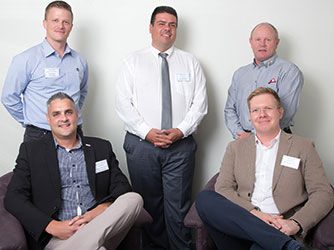

Anyone can throw a few cameras on a few poles or screw them into a wall and say they have installed a surveillance system, but will that system actually deliver value? Will the needs of the end user be met in terms of secur-ity or will they simply be able to say they have a surveillance system and perhaps get a little discount from their insurance company?
Hi-Tech Security Solutions held a round table with a few local CCTV experts to find out how one goes about extracting value from your surveillance system to ensure that it’s more than a decoration. Our round table consisted of the following people:
• Quintin van den Berg from Bosch Security and Safety Systems. Van Den Berg has been with Bosch for about two years and in the industry for much longer. Bosch offers a full range of security and safety solutions to the security market in southern Africa.
• Dene Alkema from Cathexis. Cathexis focuses on intelligent software solutions. It is a South African software development house that operates globally to drive efficient control of various different flows of information, including video.
• Franz Kersten from Panasonic South Africa. Kersten represents Panasonic’s business division. It was established in South Africa about two years ago after a long absence from the market. He is the channel manager tasked with developing the company’s channel in the region.
• Shaun Savage from Hikvision South Africa. Savage is Hikvision’s business development manager with many years under his belt in the industry. The company covers almost all segments of the market, from low-end products all the way through to high-end hardware and software solutions such as deep learning for video analytics.
• Kevin Monk from the electronics integration division of Stallion Security. The company offers a range of services, including remote monitoring and system installation across South Africa.

The danger in opting for a security solution is that the user, whether a risk or security manager, relies on a third party for advice on what they need. Of course, this shouldn’t be a danger as large installations are complex and one has to rely on experts for advice. The danger is the third party you choose will decide on a solution based on what they think you can afford (or according to your budget), instead of offering a solution designed for that particular environment.
The question we asked the attendees was, how do you know that the system you agree to will deliver the value you require?

For Savage, the process of buying a security solution is similar to that of buying a car. Today, one has a lot of information at hand and you don’t simply rely on the salesperson’s advice, you investigate whether the car will meet your needs in terms of fuel consumption, power and so on.
“Why is it any different to choosing your surveillance system? You are responsible for the security aspect of your company or environment, you should know what your needs are?”
Budgets will always be a constraint, but there also needs to be a bit of leeway to allow for better choices. Alternatively, a phased approach can be designed to make sure you get the right solution.

Kersten says he often receives calls from someone looking for a camera, but they have no idea what they want (except that it should be the cheapest). Buyers must know what their needs are and not buy at the last minute or from a grudge perspective.
“Your surveillance solution is not simply a purchase, it is an investment that you want optimal performance from for the next five years or more,” Kersten adds. “You are going into a long-term relationship that has to deliver some form of value. Therefore education and competitive quotes are a must.”
He notes that other questions to ask include whether you simply want a passive surveillance system or do you want a management tool to help you run your business? Are you going to make use of analytics, are you going to make use of other functions that are available as well, and what about integration into other systems? These all have an impact on your ultimate product selection.
Education is key

Alkema sees this as a key opportunity for system installers, integrators and consultants to be a source of expertise and to share that knowledge with the customer in the design phase. All too often, he says, users don’t really understand how to outline their requirements or do a proper needs analysis.
“I think there is a fantastic opportunity for the security industry to step up to the plate because, unfortunately, education is one of the biggest lacks in our country,” Alkema says.

Van Den Berg backs this up by noting that listening to your customer is a critical skill. “We need to understand their needs beyond what they say and educate them on the best way forward. More importantly, we need to get them to understand that there is a new monster coming to their environment.
“This is not only relevant for the security industry, but everywhere. The Internet of Things (IoT) is going to take over and this will make your choice of surveillance camera even more important as it will no longer be a dumb device with only one use. Your cameras and surveillance infrastructure will become so much more.”
Van Den Berg is clear that the IoT is going to be the game changer and one of the consequences is that services will become a bigger portion of the integrator’s business than just supplying hardware and software into an environment.
It’s all about risk

Monk adds that it’s all about identifying the client’s risk. “If you do not understand the risk, you can’t design the correct solution and meet the appropriate functional requirements.
“From this perspective, and when looking at the IoT, artificial intelligence (AI) and metadata, education is the key factor.”
At the same time, he says having the client do their own research is good, but it must be tempered with good advice as there is an endless amount of information on the Internet, but not all of it can be described as good advice. Simply researching the symptoms of a common cold online could leave you thinking you have a terminal disease.
He repeats that it all comes down to risk. Your customer may want AI, IoT and other interesting things they have read up on, but the first part of your solution must be identifying and addressing their risk. Once that is done, it’s easier to determine where AI and the rest of it fits in.
The right advice
The next logical question then is how one goes about finding the integrator or consultant that understands risk and will provide you with the right advice. The danger is deciding everything based on price or existing relationships, and losing the independence required to effectively address risk.
There are many products out there and the process of selecting the right one can be daunting. Alkema says the key is for the consultant to ask the right questions as part of a needs analysis to gain an understanding of the client’s requirements and then develop a plan to address the risks.
Similarly, asking the right questions around products from different vendors and then matching that to the requirement that was drawn up jointly by the client and by the consultant will yield the right results.
Many consultants and integrators will not simply select a product, but arrange for some form of shootout to select the technology that performs best in that particular scenario. Van Den Berg says this is appreciated by the end users as they can see the results of the shootout and actively participate in the final decision with much more confidence.
And although you don’t want your relationship with someone to push you into poor decisions, both Kersten and Monk add that relationships built on trust and delivery are a powerful force in any sales environment.
Getting to the returns
The process of deciding what you need is one thing, understanding what your returns are and how to measure them is quite another. You can tell the MD that you have cameras so nobody can break in, but how does that translate to the bottom line?
On the one hand, one can calculate the total cost of ownership (TCO) of the solution over its lifespan. Part of this TCO is showing your customers that “more is less”, explains Van Den Berg. By this he means that although you may pay more on the initial price, you actually save in the long run because the systems will require less servicing and maintenance, less air conditioning because of the design of the device and therefore less power consumption, for example. Additionally, better compression can save on storage costs.
These may be small things when considered alone at one point in time, but they add up and amount to significant savings over the long term.
Additional returns can be measured in the business benefits the system delivers. In a retail environment, for example, reduced shrinkage, better customer service, ensuring you have the right stock on site and other benefits can be measured in terms of rands and cents, and all of these can be accomplished with the assistance of what was once security surveillance technology.
And these benefits don’t need to come at an extra expense. Most camera brands today have evolved way beyond simply doing one function, adds Savage. There are many embedded functions today that customers can take advantage of out of the box and at no additional cost, but many don’t even know they exist and consequently only use a fraction of the system’s capabilities.
He offers a parking example. In a certain mall parking area, some people have the habit of parking their cars and then taking public transport to the airport and flying off to a destination. Days later they return and claim they have lost their ticket, pay an R80 fee and off they go.
Using the licence plate recognition within the cameras the mall already uses, the administrators can easily ask the customer for their licence plate number, check when they really arrived, and charge them for the full period they were parked as well as the R80 lost ticket fee.
“It’s all about knowing the product you have bought and what it can do,” he says.
Of course, while one person sees value in one area, someone else has a different responsibility and would not see the results as valuable to them. Alkema explains that it is up to the consultants and integrators to get to grips with understanding the client’s business. “What are the problems you are facing? What are your daily, monthly and annual challenges that you want to address but don’t know how?”
He agrees that there is plenty of technology out there and it can be applied in different ways, but if it is applied to address the wrong issue, the value the client is going to get at the end of the day could be negligible.
“So the starting point really is to understand the client’s business before we throw a lot of technology into an environment that might, at the end of the day, not really bring anything back into the business,” Alkema concludes.
Kersten adds that cameras are also not there only for security purposes or safety reasons anymore. “Today they are used for a variety of purposes, such as marketing through people counting, heat mapping, age, gender, racial identification and so on. It is not just a surveillance system anymore.”
Turf wars not over
While the retail environment may be one in which security technology is used for a variety of purposes, the attendees warn that this is not always the case. In many companies, the traditional silo approach is still alive and well and isn’t going anywhere.
Just look at how the IT department protects its network from people who may want to use it for their own applications. This extends to other areas as well, and to departments who are determined to control their own turf in order to ensure they meet their business responsibilities and are not distracted by the demands of other departments.
This is only exacerbated in high-security areas and businesses, such as financial institutions. So while we may see benefit in converged infrastructures in many cases, the reality is we are not going to be one big, happy, converged family for some time to come.
Grudge purchase no more
One of the positive points raised in the discussion was that getting businesses to buy security is no longer a grudge purchase, or it is heading quickly in that direction. Security is now a line item in budgets and, as Monk says, you are not finding companies scrounging for budget for some security solution because they had stock stolen and think they now need to do something.
He adds that European companies have set the tone in this regard. They want to know that their staff in South Africa are safe. Should something happen, the problem and those responsible report to the top of the organisation and this encourages a serious approach to security while discouraging the idea of security as an afterthought.
“I think that has opened doors for our industry and highlighted the importance of understanding of your client’s functional requirements and their business process – not so much their business, but their business process where technology will add value,” adds Monk.
He adds that it is not always cut and dry that technology will solve everything; there are some instances that you are unable to do without manpower intervention.
As Alkema noted, you can deploy a multi-million rand system, but it is still reliant on a person sitting in the control room to make the decision and to react to a set of operational procedures. Although the systems are getting smarter, we are still reliant on a human interface.
This only highlights the importance of choosing the right people for the job, and ensuring they are trained to perform it to standard.
At the end of the day, the bottom line is that a decent scope-of-work document in terms of the functional requirements is delivered to the client upfront and on handover is signed off by the client. “I think this is where the return on the investment is,” says Monk. “Whatever their needs are, their needs analysis has been met.”
A technical edge
No debate about surveillance would be complete without at least touching on the technology aspects of the industry. The area the round table zoned in on is that of video analytics.
This is not a new topic and today it is difficult to find a decent camera without some form of analytics. The catch mentioned by multiple attendees is that there is a vast difference between commonly distributed analytics and the latest solutions from the market leaders that provide better quality and reliability.
This includes the latest developments in AI and deep learning, which has the potential to take analytics to a completely new level.
We are already seeing a move in traditionally conservative companies that have avoided analytics because of its historical failures, to making more use of the latest technology because it actually works now. Moreover, the attendees have seen these same companies asking questions and looking into AI and deep learning, and what it can do for their surveillance operations and their businesses as a whole.
Van Den Berg believes AI is definitely the way forward, especially when the IoT comes into play. Self-learning technology is going to make an impact on the surveillance industry in the near future. He believes this will define and differentiate better quality cameras as it will all run on the edge.
In this regard, Monk says there are some clever self-learning platforms that have been launched in South Africa by South African companies. However, he believes there is still much work to be done to reach real IoT functionality in the industry.
Right now, we can see different cameras and other sensors on a network or on various networks, but the standards of interaction are still missing. By this he means that a company with various brands of cameras installed can not make use of the edge analytics on the different brands without specific software.
“With IoT, I should be able to use any camera anywhere to its fullest capabilities. That is true IoT. I believe to go and deliver a proper IoT solution is going to be very difficult in our industry.”
While some aspects of these new technologies are still in their infancy, Alkema thinks we are going to see great advancements in these fields within the next two or three years.
However, he says the challenge the IoT really faces is to be able to handle threats outside of traditional security. “As our homes become smarter, as our companies become smarter, the questions that need to be answered are how secure the edge devices that we implement in our organisations are.
“Additionally, we need to effectively manage those threats because these days your security manager or even your risk and compliance manager might not have sufficient knowledge to even understand what threats are out there. It is going to be up to us as vendors, system builders and consultants to actually understand what those threats are and advise our clients and the market effectively.”
Cyber issues to consider
Cybersecurity is as important to the surveillance market today as it is to the IT industry. It’s a given that cameras need to be made secure and firmware upgraded to the latest versions as often as they are released, but the management platform is where security should be handled from.
If a company has a cheap camera with no backing or support installed for a non-critical area, this becomes the weakest link. The management system therefore needs to ensure that this camera is functioning and as secure as the others, alerting operators if something out of the ordinary happens. The network environment will also contribute to security if managed switches are used (and managed correctly).
Of course, a consultant or integrator would be expected to advise the client of the dangers of opting for the cheap camera long before a purchase decision is made – but we know price is always a great persuader.
As far as system integrators are concerned, Monk says the top SIs are very aware of the cyber threat “and of how networking and infrastructure has become a part of our business.” These companies have made the effort to get the right skills on board to deliver a secure service to their clients. Put plainly, their future depends on it.
Van Den Berg adds, “There is a reason why the top guys are the top guys. They reinvest in their staff and they educate their guys on a regular basis.”
Looking ahead
Our final question to the attendees at this year’s round table was what they expected to see happening in the market over the next couple of years.
Savage says he sees the growth of services as a big issue in the coming years. With cameras deployed and running, companies will be able to sell services from their surveillance infrastructure. We can already see this in cases where number plate recognition is sold as a service in suburbs, but this is only the start of the services culture in the surveillance industry.
Van Den Berg says that Bosch’s focus will be integration. Bosch is already in many households and businesses with technology from fridges to coffee machines and so forth. As soon as these become interactive, your security sensor will be part of an integrated platform across multiple previously independent domains – the IoT in a nutshell – and we are able to manage and support all of it.
“One of our major drives is around effectively utilising the data that comes into our systems and trying to make it easier for security managers and operators to be able to access the right information at the right time,” says Alkema. “We are also focused on engaging and collaborating with different solutions to deliver efficiency across the board.”
Kersten says standalone systems are gone. Today we live in a world where integration, interaction and smart devices/services are expected. This requires the IoT, however you define it, in which information from multiple systems, not only surveillance is available when, where and how you need it. And this is where he sees the industry headed in the not-too-distant future.
In the system integrator market, Monk says SIs are going to start differentiating themselves through added value such as developing smart applications and functionality to run on the systems they sell and support. Many of these companies have already invested in internal development teams with the aim of setting themselves apart from the competition – it’s not going to be about who can sell you the cheapest solution anymore, it’s about what value you add and what makes you indispensable.
Hi-Tech Security Solutions would like to thank the attendees at this year’s CCTV Round Table for their time and contributions. If you have any comments or ideas about what was discussed, get in touch with us at andrew@technews.co.za
| Tel: | +27 11 543 5800 |
| Email: | malckey@technews.co.za |
| www: | www.technews.co.za |
| Articles: | More information and articles about Technews Publishing |

© Technews Publishing (Pty) Ltd. | All Rights Reserved.